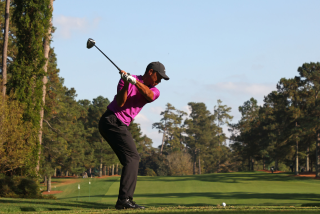Spikeless Shoes Make a Big Mark on Market
- Share via
Arnold Palmer’s swing may not be a thing of beauty, but you can’t argue about its effectiveness.
The Palmer swing is a classic, and it looks like this: He takes a huge rip at the ball, then he sort of ducks his head to one side and the other to catch sight of the ball.
If Palmer appears as if he is almost coming out of his shoes when he swings, he isn’t. In fact, he wears spikeless shoes and he believes in them.
“If I don’t slip and I can wear spikeless shoes, everybody can,” Palmer said.
There is no boundary on technology in golf these days, but perhaps the greatest advancements in recent years have come in three areas: metal woods, cavity-backed irons and spikeless shoes.
Metal spikes on the bottom of golf shoes are going the way of the persimmon driver. Many courses ban metal spikes because of the damage they do to greens. More and more clubs are requiring members to play in spikeless shoes--and more and more pros are doing it. This year, David Frost became the first to win a PGA Tour event in spikeless shows when he won the Colonial at Fort Worth.
Spikeless shoes still provide traction, with rubber or plastic inserts that have several nubs in place of metal spikes. The most popular alternative golf cleat manufacturer is Softspikes, by Foot-Joy, which debuted in 1993.
Metal woods are now standard. Many have titanium heads, some of them oversized, and graphite shafts. From the tee or the fairway, the metal woods are lighter, more powerful and more forgiving.
Cavity-backed irons have the same purpose. Many of them oversized, they’re more forgiving than the forged blades, where the sweet spot is very small. Cavity-backed irons mean fewer mis-hit balls and better performance on those shots that are mis-hit. And by moving the center of gravity lower, it allows the player to get the ball up higher in its flight . . . straight toward the hole, supposedly.
More to Read
Go beyond the scoreboard
Get the latest on L.A.'s teams in the daily Sports Report newsletter.
You may occasionally receive promotional content from the Los Angeles Times.










